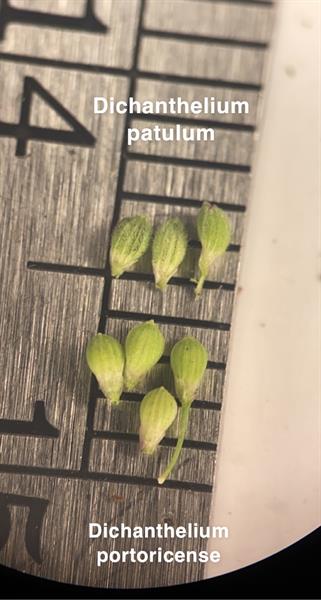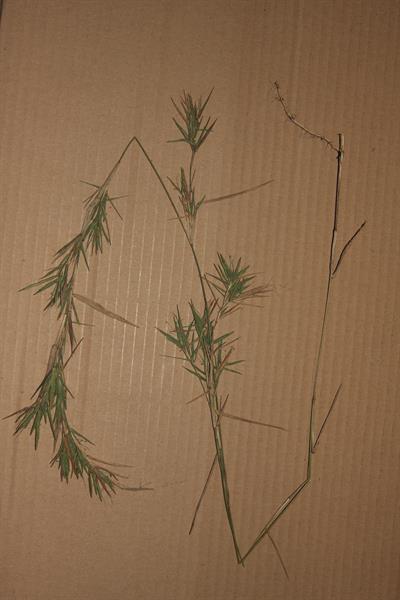
Contributed by Richard J. LeBlond
A genus of 70-100 species, perennials, of temperate and tropical America. Hitchcock & Chase (1910) established Dichanthelium as a subgenus, and it was elevated to genus by Gould (1974). Radford, Ahles, & Bell (1968) significantly reduced the number of Dichanthelium taxa recognized by Hitchcock & Chase (1910, 1950), especially in the groups treated as sections Dichanthelium (formerly section Dichotoma) and Lanuginosa in Freckmann & Lelong (2003). Gould & Clark (1978) made further reductions in the number of recognized taxa. Subsequent work has determined the reductions were excessive. Gould & Clark (1978) nearly admitted as much; in their treatment of one species group, they wrote: “The recognition of only four species and six varieties in this complex to which almost 50 species names have been applied admittedly is somewhat arbitrary and certainly not entirely satisfactory”.
Dichanthelium is one of the most complex and confusing genera in our region. A taxon that is distinct in one part of its range may be indistinguishable from another taxon elsewhere. This is particularly true of Coastal Plain species adapted to natural (and now human) disturbances. Although hybridization is frequently suspected in Dichanthelium, documentation of natural hybrids is rare.
Wipff (2020) made new combinations for 15 entities previously named as species in Panicum, but provided no arguments or discussion for the recognition. They are here included in synonymy until their validity can be determined.
ID notes:Dichanthelium is most readily (though not consistently) separated from Panicum by the following combination of features: plants producing over-wintering rosettes of leaves often shorter and broader than the culm leaves; plants producing simple culms with terminal panicles in spring or early summer, then producing terminal panicles on primary branches, followed by often hidden or obscured panicles on secondary (etc.) branching. Virtually all treatments refer to two flowering phases: vernal (or primary), and autumnal (or secondary). Little understood is that almost all taxa in the genus appear to have three flowering periods. An intermediate stage between vernal and autumnal was recognized by Hitchcock & Chase (1910), who wrote: “In this group there is an intermediate stage of branching, in which the plants do not show the characteristic vernal nor autumnal habit”. Silveus (1942) also recognized the intermediate stage, and described its features for several taxa. The three floral stages are, in phenological order: panicle terminating the culm (vernal stage), panicles terminating the primary branches (intermediate or aestival stage), and panicles on secondary branches (autumnal stage). Complicating matters, the three stages tend to overlap, and the autumnal stage in most species begins in summer, not autumn. Also, the autumnal stage can rebranch two or more times. As in the terminal vernal inflorescences, the intermediate stage panicles at the ends of the primary branches tend to disarticulate later in the season. On most specimens collected in the autumnal stage, the only evidence of the primary branching stage (besides the branch itself) is the presence of some intermediate-sized blades subtending the later autumnal fascicles, along with evidence of the branch having lost its terminal portion. Autumnal inflorescences are usually short-exserted and more-or-less hidden among the fascicled leaves, sometimes even partly included in the sheaths. This treatment relies on the vernal and autumnal stages for distinguishing among the many taxa, as key characters from the intermediate stage have not been developed. Care must be taken to distinguish the pubescence of the ligule from any pubescence emanating from the inner surface of the blade base, and from marginal cilia. Some taxa have what is referred to as a double ligule: a dense ring of short hairs 0.5-1 mm long at the ventral summit of the sheath, and behind it a ring of longer hairs 1-5 mm long called the pseudoligule, which is attached to the base of the blade. At first glance, the hairs appear to form a single structure. The true, short ligule is most easily seen toward the edges (excluding cilia), and by tilting the blade away from the sheath axis.
Key advice:The genus requires careful collection and close observation of several characters. Mature spikelets are essential; in most species, autumnal spikelets have the same dimensions as vernal spikelets. When collecting plants in the autumnal stage, try to select specimens still possessing their vernal leaf blades and panicles, even though these will be senescent. It is also important to collect the whole plant, with the basal rosette intact (whether senescent or of current year's growth). When several plants are growing together, compare the culm, leaf, and spikelet features for differences, as multiple species are often present in the same microhabitat.
When analyzing the character of the culm internodes and nodes, begin with the first elongate internode above the base (the lowest internode is often very short and uncharacteristic). Determining whether a node is bearded is often difficult. A bearded node usually is characterized by pubescence that is longer, denser, and/or of a different orientation or structure than adjacent pubescence on the internode. Nodes with short and appressed pubescence generally are not regarded as bearded. Lower nodes are more likely to be bearded than upper nodes. Some internodes are described as “crisp-puberulent”. This condition is characterized by a dense covering of minute hairs mostly less than 0.1 mm long, and usually crimped or curved; glandular hairs or protuberances are often intermixed. When analyzing sheaths, look at those on the lower half of the culm. Senescent vernal sheaths often lose their pubescence (though in some species hair papillae are evident). All references in the key to sheath glabrousness or pubescence is without regard to the presence or absence of marginal hairs (cilia). A sheath that is glabrous except for marginal cilia is called glabrous. All culm leaves should be analyzed for blade characters; in general, the key relies on the size and character of the vernal blades. A “cordate” blade is one where the basal lobes of the blade extend outward and partially surround the culm when the culm is enclosed by the sheath. As with sheaths, references in the key to blade glabrousness or pubescence is without regard to marginal cilia. The ligule is an important diagnostic character for many Dichanthelium taxa; at least three ligules per specimen should be examined before making conclusions about its structure and length. Ligules form a distinct ring from a cartilaginous base at the inner summit of the sheath; in some species the ligule is membranous, but in most it is ciliate. Care must be taken to distinguish the pubescence of the ligule from any pubescence emanating from the inner surface of the blade base, and from marginal cilia. Ligules of senescent vernal leaves frequently lose their integrity. Spikelet shape as well as length should be determined only from mature spikelets. Measure the length from the base of the first glume (usually at an articulation) to the apex of the second glume or sterile lemma (whichever is longer). A micrometer is essential for determining the length of spikelets, first glumes, ligules, and various pilosity features. Sometimes one-tenth of a millimeter is important in separating two Dichanthelium taxa.
Certain characters, particularly node bearding, cordate/non-cordate blade bases, and ligule length, can be quite variable, and an effort has been made to account for this variability in the key. Nonetheless, some specimens just will not "fit", and the road not taken may have to be reconsidered.
Ref: Ciafré & Estes(2022); Davidse & Pohl (1992); Early (2022); Freckmann (1981); Freckmann & Lelong (2002); Freckmann & Lelong (2003a) In Flora of North America Editorial Committee (2003a); Frye, McAvoy, & Thomas (2022); Gould (1974); Gould & Clark (1978); Hansen & Wunderlin (1988); Hitchcock & Chase (1910); Hitchcock & Chase (1950); LeBlond (2001a); LeBlond (2011) In Weakley et al. (2011); LeBlond (2016); LeBlond (2017a) In Weakley et al. (2017); LeBlond (2017b) In Weakley et al. (2017); LeBlond (2017c) In Weakley et al. (2017); LeBlond (2018b) In Weakley et al. (2018a); LeBlond (2019a) In Weakley et al. (2019a); LeBlond (2020); LeBlond et al. (2017); LeBlond, Townsend, & Ludwig (2020); Lelong (1984); Radford, Ahles, & Bell (1968); Schuyler (1996); Silveus (1942); Thomas (2008); Thomas (2021); Wipff (2020); Wipff (2022). Show full citations.
Hover over a shape, letter, icon, or arrow on the map for definition or see the legend. Data for arrows not developed for genera and families which may have species only occurring outside the flora area.
 © Gary P. Fleming | Dichanthelium acuminatum var. fasciculatum | Original Image ⭷
© Gary P. Fleming | Dichanthelium acuminatum var. fasciculatum | Original Image ⭷ © Scott Ward | Dichanthelium boscii | Original Image ⭷
© Scott Ward | Dichanthelium boscii | Original Image ⭷ © Bruce A. Sorrie | Dichanthelium neuranthum | Original Image ⭷
© Bruce A. Sorrie | Dichanthelium neuranthum | Original Image ⭷ © Keith Bradley, some rights reserved (CC BY-NC), uploaded by Keith Bradley | Dichanthelium strigosum var. strigosum source | Original Image ⭷ Warning: was NOT research grade.
© Keith Bradley, some rights reserved (CC BY-NC), uploaded by Keith Bradley | Dichanthelium strigosum var. strigosum source | Original Image ⭷ Warning: was NOT research grade. © Aidan Campos | Dichanthelium scribnerianum source | Original Image ⭷
© Aidan Campos | Dichanthelium scribnerianum source | Original Image ⭷ © Scott Ward | Dichanthelium arenicoloides | Original Image ⭷
© Scott Ward | Dichanthelium arenicoloides | Original Image ⭷ © Keith Bradley | Dichanthelium clandestinum | Original Image ⭷
© Keith Bradley | Dichanthelium clandestinum | Original Image ⭷ © Scott Ward | Dichanthelium boscii | Original Image ⭷
© Scott Ward | Dichanthelium boscii | Original Image ⭷ © Bruce A. Sorrie | Dichanthelium oligosanthes | Original Image ⭷
© Bruce A. Sorrie | Dichanthelium oligosanthes | Original Image ⭷ © Gary P. Fleming | Dichanthelium depauperatum | Original Image ⭷
© Gary P. Fleming | Dichanthelium depauperatum | Original Image ⭷ © Gary P. Fleming | Dichanthelium annulum | Original Image ⭷
© Gary P. Fleming | Dichanthelium annulum | Original Image ⭷ © Bruce A. Sorrie | Dichanthelium wrightianum | Original Image ⭷
© Bruce A. Sorrie | Dichanthelium wrightianum | Original Image ⭷ © Scott Ward | Dichanthelium portoricense ssp. patulum | Original Image ⭷
© Scott Ward | Dichanthelium portoricense ssp. patulum | Original Image ⭷ © Keith Bradley | Dichanthelium boscii | Original Image ⭷
© Keith Bradley | Dichanthelium boscii | Original Image ⭷ © Scott Ward | Dichanthelium scabriusculum | Original Image ⭷
© Scott Ward | Dichanthelium scabriusculum | Original Image ⭷ © Gary P. Fleming | Dichanthelium boscii | Original Image ⭷
© Gary P. Fleming | Dichanthelium boscii | Original Image ⭷ © Bruce A. Sorrie | Dichanthelium aciculare | Original Image ⭷
© Bruce A. Sorrie | Dichanthelium aciculare | Original Image ⭷ © Bruce A. Sorrie | Dichanthelium depauperatum | Original Image ⭷
© Bruce A. Sorrie | Dichanthelium depauperatum | Original Image ⭷ © Bruce A. Sorrie | Dichanthelium caerulescens | Original Image ⭷
© Bruce A. Sorrie | Dichanthelium caerulescens | Original Image ⭷ © Bruce A. Sorrie | Dichanthelium aciculare | Original Image ⭷
© Bruce A. Sorrie | Dichanthelium aciculare | Original Image ⭷ © Keith Bradley | Dichanthelium scoparium | Original Image ⭷
© Keith Bradley | Dichanthelium scoparium | Original Image ⭷ © Joey Shaw | Dichanthelium ravenelii source | Original Image ⭷
© Joey Shaw | Dichanthelium ravenelii source | Original Image ⭷Feedback
See something wrong or missing on about Dichanthelium? Let us know here: (Please include your name and email if at all complicated so we can clarify if needed.)
Cite as...